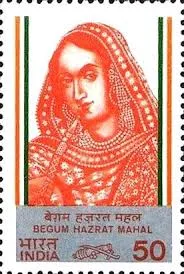Hazrat Mahal: The Fearless Queen Who Defied Empires in India's Struggle for Independence
In the tapestry of India's struggle for independence, Hazrat Mahal stands out as a symbol of fearless leadership and unwavering determination. Born in 1820, she became a central figure in the Indian Rebellion of 1857, also known as the First War of Independence, where she led a courageous resistance against the British East India Company.
Hazrat Mahal, originally known as Muhammadi Khanum, was born into a noble Persian family. She later became the wife of Nawab Wajid Ali Shah of Awadh (Oudh), a prominent princely state in northern India. Following her husband's deposition by the British in 1856, Hazrat Mahal found herself thrust into the tumultuous landscape of colonial rule.
The Indian Rebellion of 1857 was a turning point in Hazrat Mahal's life. Faced with the annexation of Awadh and the exiling of her husband, she emerged as a formidable leader of the rebel forces. In Lucknow, she took charge of the affairs and led a daring resistance against the British, refusing to surrender to the oppressive forces of colonial rule.
The Siege of Lucknow became a defining moment in Hazrat Mahal's leadership. As the British laid siege to Lucknow, Hazrat Mahal displayed exceptional courage and strategic brilliance. She rallied both soldiers and civilians, orchestrating a spirited defense against the British forces. Her determination and fearlessness became a source of inspiration for those who fought alongside her.
Despite facing immense odds, Hazrat Mahal refused to capitulate to the British. Her valor and sacrifice left an indelible mark on the struggle for independence. Hazrat Mahal's legacy resonates as a testament to the countless women who stood at the forefront of the fight against colonial oppression, challenging traditional gender norms and becoming leaders of resistance.
After the suppression of the rebellion, Hazrat Mahal sought asylum in Nepal. Her life post-rebellion remains shrouded in historical mystery, but her memory continued to live on as a symbol of resistance. In modern India, Hazrat Mahal is remembered and revered for her fearless stand against injustice and tyranny.
Hazrat Mahal's contributions have been commemorated through various memorials and cultural references. The Hazrat Mahal Park in Lucknow and her portrayal in literature and art stand as testaments to her enduring legacy. Her story is a reminder of the formidable role played by women in India's quest for independence.
Hazrat Mahal's life exemplifies the spirit of resilience and defiance against colonial rule. Her fearlessness and leadership during the Indian Rebellion of 1857 echo through history, inspiring generations to stand up against oppression. Hazrat Mahal, the fearless queen, remains eternally etched in the collective memory of India's struggle for independence.
Tags:
colonial oppression
fearless queen
Hazrat Mahal
historical hero
Independence Struggle
Indian history
Indian Rebellion of 1857
Story of India
